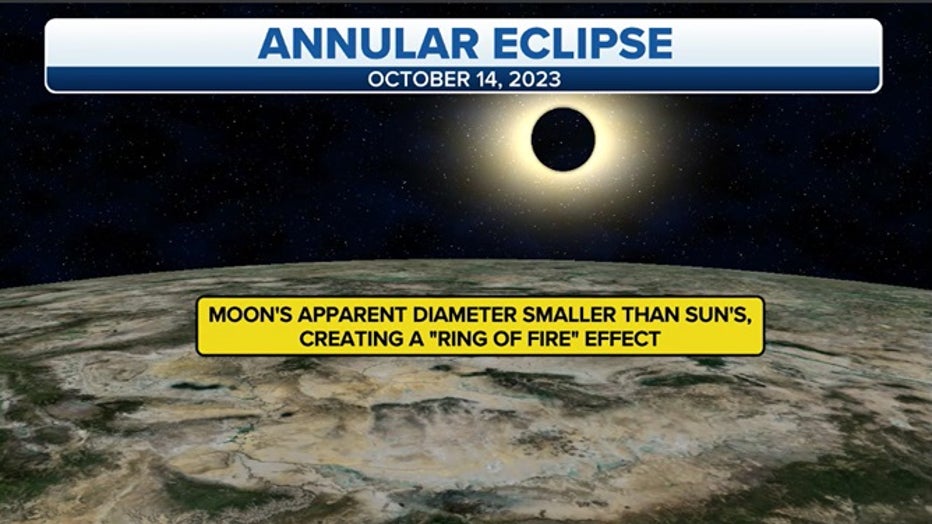Solar eclipse to be visible in North Texas Saturday
DALLAS - People in South Texas are preparing for an amazing view of an annular solar eclipse happening this weekend. For those of us in North Texas, the view will still be pretty good.
According to FOX Weather, nine states are along the path of the maximum eclipse, which stretches from Oregon to Texas. The peak solar eclipse will be visible across the Lone Star State from the Big Bend to the Gulf Coast of Texas.

How to watch the 2023 solar eclipse in Dallas
FOX 4 Weather Meteorologist Kylie Capps talks about Saturday's annular eclipse. She says the best place to watch it will be in the San Antonio area. But you'll still get a partial view if you watch here in the Dallas-Fort Worth Metroplex.
Here's what you need to know about viewing the 2023 annular solar eclipse in Texas.
What is an annular eclipse?

Annular solar eclipse (FOX Weather)
An annular eclipse is not a total eclipse, as the Moon doesn’t entirely block the Sun’s light – only 90%. An annular eclipse happens when the Moon is at the farthest point in its orbit of Earth.
During the maximum eclipse, known as annularity, the light from the Sun peaks out around the Moon, creating the "ring of fire" the annular eclipse is known for.
When is the solar eclipse in Texas?

Each state from Oregon to Texas with the path of solar eclipse highlighted. (FOX Weather)
In the U.S., the eclipse begins in Oregon on Saturday at 8:06 a.m. PDT, and the partial eclipse ends in southeastern Texas just after 1:30 p.m. CDT.
When the eclipse starts and ends, it will vary by only a few minutes across Texas, but a partial eclipse will be visible across the state just after 10:15 a.m. CDT.
Starting where the Texas panhandle and West Texas meet, eclipse viewers in Odessa will be able to see the "ring of fire" at 11:43 a.m. Annularity lasts for just under 5 minutes in West Texas. Maximum eclipse happens at 11:45 a.m. in Midland, also for about 5 minutes.

San Angelo and San Antonio are also along the 125-mile path of the maximum eclipse. Annularity in San Antonio begins at 11:52 a.m. and lasts just over four minutes.
Finally, the "ring of fire" exits Texas on the Gulf Coast and will be visible for about 5 minutes in Corpus Christi beginning at 11:55 a.m. CDT.
Where can I see the 'ring of fire' in Texas?

The forecast on Oct. 14 along the solar eclipse path in Texas.
The annular solar eclipse will cut a path from West Texas to the Gulf Coast, offering millions the chance to see the features this eclipse is known for, including the "ring of fire," the Diamond Ring and Baily's Beads.
Those smack dab in the middle of the 125-mile-wide eclipse path will have the longest time to see annularity.
Historic sites in the Lone Star State, including The Alamo Mission in San Antonio, are along the annular solar eclipse path on Saturday.
Even those on the outer edges of the eclipse path will have a brief chance to see the "ring of fire."

On the Gulf Coast, the Aransas National Wildlife Refuge and Matagorda Island National Wildlife Refuge are on the northern limits of annularity. They will see the maximum eclipse for just over 1 minute.
Texas Parks and Wildlife is also inviting people to watch from several state parks.
Will I be able to see the solar eclipse in Dallas-Fort Worth?

Perot Museum to host solar eclipse event Saturday
On Saturday, an annular solar eclipse will sweep across the country forming what will look like a "ring of fire" around the moon. Good Day's Hanna Battah reports live from the Perot Museum where they are preparing for a big watch party.
The Dallas-Fort Worth area will get about an 80% view of the eclipse.
According to the FOX 4 Weather team, the weather will cooperate nicely in North Texas. Saturday morning is expected to be sunny with no cloud cover.
High temperatures will be in the mid-70s throughout the day with a slight breeze.
How can I watch the solar eclipse?

How to build a solar eclipse viewer
FOX 4 meteorologist Ali Turiano explains the best way for you to view a solar eclipse safely. All it takes is a few items you probably already have around the house. The annular solar eclipse will be visible in North Texas on Saturday.
If you plan to watch the eclipse, it’s crucial that you have the right protective eyewear or something like a homemade pinhole viewer.
Experts say you should not watch an eclipse through a camera lens, telescope, or binoculars without a special solar filter.
"Exposing your eyes to the sun without proper protection during an eclipse can also cause eclipse, blindness, or what we call retinal burns. And in optometry we call that solar retinopathy," said Scott Allison, an optometrist.
Featured
How to safely watch a solar eclipse
With solar eclipses happening across the U.S. in 2023 and 2024, it's time to prepare to look at the Sun – with proper eye protection or filters.
The Perot Museum in Dallas is teaming up with the Carnegie Institution to host a watch party. Ticket prices include solar glasses.
The eclipse will be happening during the University of North Texas's 11 a.m. home football game against the Temple Owls. Everyone entering the stadium will get solar-certified glasses for safe viewing.
NASA will livestream the eclipse to provide the best view of it online.
FOX Weather contributed to this report. For more coverage of the October annular solar eclipse in Texas, visit www.foxweather.com/earth-space/where-to-see-ring-of-fire-texas-annular-solar-eclipse.



